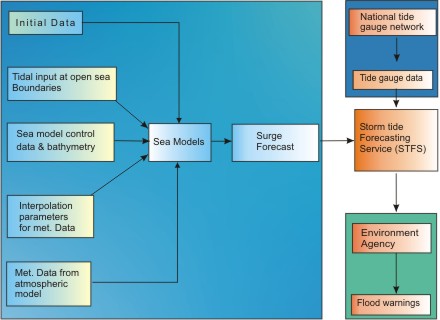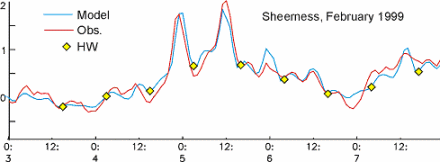Maintenance and development of operational tide-surge models
The National Oceanography Centre Liverpool works with the Met Office to develop storm surge forecasting models for the Environment Agency.

Tide-surge models are run in real-time as part of the forecast suite of models at the Met Office. Results are transmitted to the Environment Agency and used, together with data from the National Tide Gauge Network, for coastal flood warning in England and Wales.
The first operational surge forecasts were run in 1978 using coarse grid surge and atmospheric models. The current system uses the 7-km NEMO model. The previous system comprised a 12-km shelf model (CS3X), with refinements to 1km and a 1-D river model to provide useful predictions in the complex regime of the Bristol Channel and Severn Estuary.

Surge models run four times per day producing forecasts up to two days ahead. The model surge is combined with tides predicted at tide gauge sites to give the best estimate of the total water level. The Bristol Channel models have also been tuned to provide accurate water level forecasts, eliminating some problems in combining tide and surge in this highly non-linear area.

Model performance is routinely monitored at the National Oceanography Centre Liverpool by comparing forecast results with observations every month. Typical root-mean-square errors are about 10cm. Significant forecast errors are investigated and causes diagnosed so that the system can be progressively improved.
Flood warnings from the
Storm surge animations
View zoomed-in animations for:
Water level 15-min interval forecast
Surge level 15-min interval forecast
Surge animation (15-minute interval)
This 2½-day forecast animation shows the total water level of tide plus storm surge progressing around the coast of the UK. The highest water level is coloured red, while the lowest level is coloured dark blue. If a high tide occurs during a large positive surge then coastal flooding is likely.
Surge animation (15-minute interval)
This 2½-day forecast animation shows a storm surge progressing around the coast of the UK. The largest positive surge is coloured dark magenta, while the largest negative surge is coloured dark green. If a high tide occurs during a large positive surge then coastal flooding is likely.
Surge model outputs
View the lastest surge forecasts from the UK operational storm surge model.